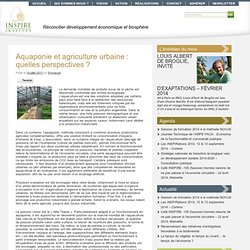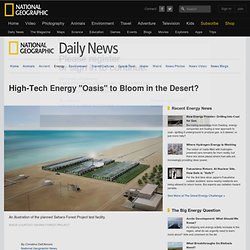

Aquaponie et agriculture urbaine : quelles perspectives ? La demande mondiale de produits issus de la pêche est désormais confrontée aux limites écologiques.

L’aquaculture est une des solutions adoptées par certains pays pour faire face à la raréfaction des ressources halieutiques, mais elle est fortement critiquée par les organisations environnementales pour sa forte consommation en eau et la pollution engendrée. Dans le même temps, une forte pression démographique et une urbanisation croissante entrainent un étalement urbain empiétant sur les espaces ruraux, notamment ceux dédiés à la production maraîchère. Dans ce contexte, l’aquaponie, méthode consistant à combiner plusieurs productions agricoles complémentaires, offre une solution limitant la consommation d’espace, d’intrants et d’eau.
L’association, dans un système intégré de l’aquaculture (élevage de poissons) et de l’hydroponie (culture de plantes hors-sol), permet d’économiser 90% d’eau par rapport aux deux systèmes utilisés séparément. Le poisson choisi est le « Nile Tilapia ». TEDxTokyo - Yuichi Mori - Soil-free Agriculture - [English] Green Energy "Oasis" to Bloom in the Desert? A renewable-energy "oasis" slated to be built in 2010 may serve as a proving ground for new technologies designed to bring green living to the desert.

The planned research center is part of the Sahara Forest Project—but that doesn't mean it'll be built in Africa. Sahara means "desert" in Arabic, and the center is meant to be a small-scale version of massive green complexes that project managers hope to build in deserts around the globe. (See pictures of the planned Sahara Forest Project reseach center.) Experts are now examining arid sites in Australia, the U.S., the Middle East, and Africa that could support the test facility. "The Sahara Forest Project is a holistic approach for creation of local jobs, food, water, and energy, utilizing relatively simple solutions mimicking design and principles from nature," said Frederic Hauge, founder and president of the Norwegian environmental nonprofit the Bellona Foundation. (Related: "Africa-wide 'Great Green Wall' to Halt Sahara's Spread?
") Kirsten Dirksen: Soil-less Sky Farming: Rooftop Hydroponics on NYC Restaurant (Video) I stepped onto the roof of the West Village restaurant Bell, Book and Candle and caught a glimpse of the future.

I was surrounded by 60 white plastic towers seemingly sprouting from the floor. Seventy varieties of herbs, vegetables and fruits dripped from the towers, but there was no dirt up here. Chef John Mooney -- my tour guide -- is able to grow nearly two-thirds the vegetables for his restaurant precisely because he doesn't rely on soil. Instead, Mooney and his partner Mick O'Sullivan have installed 60 vertical tower hydroponic systems creating a plastic, vertical, dirt-free garden. As Mooney describes, hydroponics rely on "liquid soil. " It's no coincidence that this glowing white rooftop sprouting pods looks like the future. I think in the next 10 years it will be so common. Hydroponic growing requires a constant circulation of water, but Mooney and O'Sullivan have limited themselves to clean power.
More local food videos from faircompanies: